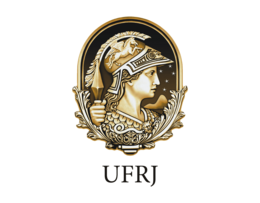
Back Universidade Federal do Rio de Janeiro ALS الجامعة الاتحادية لريو دي جانيرو Arabic Universidá Federal de Rio de Janeiro AST Rio-de-Janeyro Federal Universiteti Azerbaijani Рио-де-Жанейро федераль университеты Bashkir Federalni univerzitet Rio de Janeiro BS Universitat Federal de Rio de Janeiro Catalan Federal University of Rio de Janeiro CEB Federální univerzita v Rio de Janeiro Czech Universidade Federal do Rio de Janeiro Danish
Universidade Federal do Rio de Janeiro | |
 | |
Other names | UFRJ |
|---|---|
| Motto | A Universidade do Brasil |
Motto in English | "The University of Brazil" |
| Type | Public research university |
| Established | December 16, 1792 (231 years) (Royal Academy) September 7, 1920 (103 years) (University)[1] |
| Budget | R$3.8 billion (2020)[2] |
| Rector | Roberto de Andrade Medronho[3] |
Academic staff | 4,218 (2021)[4] |
Administrative staff | 9,153 (2021)[4] |
| Students | 69,200 (2021)[4] |
| Undergraduates | 53,500 (2021)[4] |
| Postgraduates | 15,700 (2021)[4] |
| Location | , , Brazil 22°51′45″S 43°13′26″W / 22.86250°S 43.22389°W |
| Campus | University town 2,338 acres (946 ha) (Main campus) 3 municipalities |
| Colors | Yellow and White |
| Mascot | Minerva |
| Website | ufrj.br |
 | |
The Federal University of Rio de Janeiro (UFRJ),[a] alternatively known as University of Brazil,[b] is a public research university in Rio de Janeiro, Brazil. It is the largest federal university in the country and is one of the Brazilian centers of excellence in teaching and research.[6]
Brazil's first official higher education institution,[7] it has operated continuously since 1792, when the "Real Academia de Artilharia, Fortificação e Desenho" (Royal Academy of Artillery, Fortification and Design, precursor to the university's current Polytechnic School) was founded,[8] and served as basis for the country's college system since its officialization in 1920.[9] Besides its 157 undergraduate and 580 postgraduate courses, the UFRJ is responsible for seven museums, most notably the National Museum of Brazil, nine hospitals, hundreds of laboratories and research facilities and forty-three libraries. Its history and identity are closely tied to the Brazilian ambitions of forging a modern, competitive and just society.[10]
The university is located mainly in Rio de Janeiro, with satellites spreading to ten other cities. Its main campuses are the historical campus of "Praia Vermelha" (Red Beach) and the newer "Cidade Universitária" (College City), which houses the "Parque Tecnológico do Rio" (Technology Park of Rio) - a science, technology and innovation development cluster. There are also several off-campus units scattered in Rio de Janeiro: the School of Music, the College of Law Studies, the Institute of Philosophy and Social Sciences and the Institute of History, in downtown Rio; the National Museum and the Valongo Observatory (not to be confused with the National Observatory); and the high-school unit "Colégio de Aplicação" (Application College) in Lagoa. To the city of Macaé, located in the State's northern region, was dedicated a research and learning center focused on environmental issues and oil-related matters, and the city of Duque de Caxias, in partnership with the National Institute of Metrics, Normalization and Industrial Quality (Inmetro), saw the implementation of "Pólo Avançado de Xerém" (Advanced Center of Xerém), aimed at boosting research in the fields of biotechnology and nanotechnology.
UFRJ is one of the main actors in the formation of the Brazilian intellectual elite, contributing significantly to build not only the history of Rio de Janeiro but also of Brazil. Some of its former students include renowned economists Carlos Lessa and Mário Henrique Simonsen; Minister Marco Aurélio Mello; the architect Oscar Niemeyer; the philosopher and politician Roberto Mangabeira Unger; the educator Anísio Teixeira; the engineer Benjamin Constant; writers Clarice Lispector, Jorge Amado and Vinicius de Moraes; politicians Francisco Pereira Passos, Oswaldo Aranha and Pedro Calmon, besides the great physicians Carlos Chagas, Oswaldo Cruz and Vital Brazil.
- ^ "Universidade Federal do Rio de Janeiro". Archived from the original on 4 December 2013. Retrieved 5 July 2015.
- ^ "Universidade Federal do Rio de Janeiro - UFRJ - Portal da transparência".
- ^ Emília. "Reitoria – Universidade Federal do Rio de Janeiro". Ufrj.br. Retrieved 2022-05-28.
- ^ a b c d e UFRJ (April 14, 2022). "Fatos e números" (in Portuguese). Retrieved October 1, 2022.
- ^ "Folha Online - Educação - UFRJ vai voltar a se chamar Universidade do Brasil - 01/12/2000 19h46". Retrieved 5 July 2015.
- ^ "Lista das maiores universidades brasileiras em número de matrículas" (PDF). Retrieved 9 January 2012.
- ^ "Conde De Resende, O Fundador Do Ensino Militar Academico Nas Americas E Do Ensino Superior Civil No Brasil Em 792 E O Criador Da Cidade E Municipio De Resende Em 1801 : Claudio Moreira Bento". Ihp.org.br. Archived from the original on 24 September 2015. Retrieved 5 July 2015.
- ^ "UFRJ em números Ano 2012" (PDF). Historiamilitar. Archived from the original (PDF) on 2016-03-03. Retrieved 2016-03-31.
- ^ "Archived copy" (PDF). Archived from the original (PDF) on October 18, 2011. Retrieved January 24, 2014.
{{cite web}}: CS1 maint: archived copy as title (link) - ^ "SPE UFRJ Student Chapter". Archived from the original on December 15, 2011. Retrieved January 24, 2014.
Cite error: There are <ref group=lower-alpha> tags or {{efn}} templates on this page, but the references will not show without a {{reflist|group=lower-alpha}} template or {{notelist}} template (see the help page).
© MMXXIII Rich X Search. We shall prevail. All rights reserved. Rich X Search